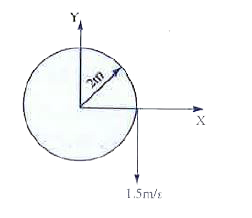A particle is moving a circular path in xy-plane. When it crosses x-axis, it has an acceleration along the path of 1.5m/s2, and is moving with a speed of 10 m/s in -ve y - direction. The total accelration is

50ˆi−1.5ˆjm/s2
10ˆi−1.5ˆjm/s2
−50ˆi−1.5ˆjm/s2
1.5ˆi−50ˆjm/s2
The correct Answer is:C
Similar Questions
A particle is moving along a circular path in xy-plane. When it crosses x-axis, it has an acceleration along the path of 1.5m/s2, and is moving with a speed of 10m/s in -ve y - direction. The total acceleration is

View SolutionA particle is moving on a circular path with constant speed, then its acceleration will be constant in
View Solution
Knowledge Check
A particle is moving along a circular path in xy-plane.When its crosses x-axis,it has an acceleration along the path of 1.5m/s2, and is moving with a speed of 10m/s in −ve y-direction.The total acceleration is
 A50ˆi−105ˆjm/s2B10ˆi−1.5ˆjm/s2C−50ˆi−1.5ˆjm/s2D1.5ˆi−50ˆjm/s2
A50ˆi−105ˆjm/s2B10ˆi−1.5ˆjm/s2C−50ˆi−1.5ˆjm/s2D1.5ˆi−50ˆjm/s2A particle is moving on a circular path with constant speed, then its acceleration will be
AZeroBExternal radial accelerationCInternal radial accelerationDConstant accelerationFor a particle moving along a circular path with a constant speed, the accelerationis constant in
Amagnitude onlyBdirection onlyCboth magnitude and directionDneither magnitude nor direction
A particle is moving on a circular path of radius 1 m with 2 m/s. If speed starts increasing at a rate of 2m/s2, then acceleration of particle is
View SolutionA particle is moving on a circular path of radius 1 m with 2 m/s. If speed starts increasing at a rate of 2m/s2, then acceleration of particle is
View SolutionA particle is revolving in a circular path of radius 2 m with constant angular speed 4 rad/s. The angular acceleration of particle is
View SolutionA particle is revolving in a circular path of radius 2 m with constant angular speed 4 rad/s. The angular acceleration of particle is
View SolutionIf a particle is moving along a circular path with constant speed, then Its motion is
View Solution
